Статьи журнала - International Journal of Image, Graphics and Signal Processing
Все статьи: 1056
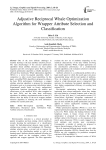
Adjustive reciprocal whale optimization algorithm for wrapper attribute selection and classification
Статья научная
One of the most difficult challenges in machine learning is the data attribute selection process. The main disadvantages of the classical optimization algorithms based attribute selection are local optima stagnation and slow convergence speed. This makes bio¬-inspired optimization algorithm a reliable alternative to alleviate these drawbacks. Whale optimization algorithm (WOA) is a recent bio-inspired algorithm, which is competitive to other swarm based algorithms. In this paper, a modified WOA algorithm is proposed to enhance the basic WOA performance. Furthermore, a wrapper attribute selection algorithm is proposed by integrating information gain as a preprocessing initialization phase. Experimental results based on twenty mathematical optimization functions demonstrate the stability and effectiveness of the modified WOA when compared to the basic WOA and the other three well-known algorithms. In addition, experimental results on nine UCI datasets show the ability of the novel wrapper attribute selection algorithm in selecting the most informative attributes for classification tasks.
Бесплатно
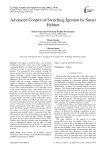
Advanced control of switching ignition by smart helmet
Статья научная
The impact of Accident effect, a lot of human livelihoods and their career, due to the negligence of wearing the helmets on a daily basis in India. To end this suffering, we have a social responsibility development projects. The motorcycle driver without wearing the helmet can be killed if it hit or crash and bring his life in danger. Wearing a helmet reduces the possibility of danger of life. In India, for example, wearing a helmet is mandatory in the law and the drivers need to follow it. Similar rules are in many countries. Therefore, this project is designed to improve motorcycle safety and make motorcyclist compulsory for wearing it. As you can see, we have a lot to think about it. It is a type that is used in the driver's helmet to drive a bike safely. The aim of this paper is to protect the driver life and decrease the death rate at road accident by making the helmet. It uses a hands-free kit and advances feature like compulsory of wearing helmet and theft security. Bluetooth wireless communication module (2.4 GHz band transceiver) can be used for transmission between the transmitter and the receiver. The driver needs to wear a helmet otherwise a helmet automatically keeps the engine OFF. If rider wears the helmet, ignition will be automatically ON. In the sensor, we transmit information to the wireless communication module, which is connected to the bike. This system is one of the devices built in the helmet; the second devices are inside the bike. Monitor recognizes the power devices with a Force-sensing resistor (FSR). Wireless data receiver, encoder, and a transmitter are used to communicate helmet with the bike. AT mega controller in both devices used as a CPU. It is one of the most advanced electronic projects for the Road Safety Systems.
Бесплатно
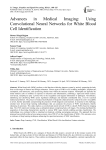
Advances in Medical Imaging: Using Convolutional Neural Networks for White Blood Cell Identification
Статья научная
White blood cells (WBC) perform a vital function within the immune system by actively protecting the body from a wide range of diseases and foreign substances. Diverse types of WBCs exist, including neutrophils, lymphocytes, eosinophils, and monocytes, each possessing distinct roles within the immune response. Neutrophils are typically the initial immune cells to mobilize in response to infections and inflammation, exhibiting a rapid and robust reaction. Conversely, lymphocytes play a pivotal role in the recognition and targeted elimination of pathogens. Nevertheless, identifying and classifying WBCs poses significant challenges and demands considerable time, even for seasoned medical practitioners. The process of manual classification is frequently characterized by subjectivity and is susceptible to errors, thereby potentially compromising the precision of both diagnosis and treatment. In response to this challenge, scholars have devised deep learning methodologies that can automate the process of WBC classification, thereby enhancing its precision. This study employs a convolutional neural network (CNN) to classify WBCs based on imaging data. The CNN underwent training using a substantial dataset comprising body cell images. This training facilitated the acquisition of discerning characteristics specific to various WBC types, thereby enabling accurate classification. The methodology was evaluated within a simulated environment, yielding encouraging outcomes. The approach that was proposed successfully achieved an average accuracy rate of 98.33% in the classification of WBCs. This outcome serves as evidence of deep learning techniques enhancing the speed and accuracy of WBC classification.
Бесплатно
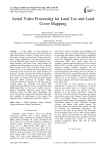
Aerial Video Processing for Land Use and Land Cover Mapping
Статья научная
In this paper, we have proposed an Automatic Aerial Video Processing System for analyzing land surface features. Analysis of aerial video is done in three steps a) Image pre-processing b) Image registration and c) Image segmentation. Using the proposed system, we have identified Land features like Vegetation, Man-Made Structures and Barren Land. These features are identified and differentiated from each other to calculate their respective areas. Most important feature of this system is that it is an instantaneous video acquisition and processing system. In the first step, radial distortions of image are corrected using Fish-Eye correction algorithm. In the second step, the image features are matched and then images are stitched using Scale Invariant Feature Transform (SIFT) followed by Random Sample Consensus (RANSAC) algorithm. In the third step, the stitched images are segmented using Mean Shift Segmentation and different structures are identified using RGB model. Here we have used a hybrid system to identify Man-Made Structures using Fuzzy Edge Extraction along with Mean Shift segmentation. The results obtained are compared with the ground truth data, thus evaluating the performance of the system. The proposed system is implemented using Intel's OpenCV.
Бесплатно
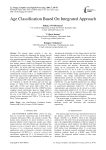
Age Classification Based On Integrated Approach
Статья научная
The present paper presents a new age classification method by integrating the features derived from Grey Level Co-occurrence Matrix (GLCM) with a new structural approach derived from four distinct LBP's (4-DLBP) on a 3 x 3 image. The present paper derived four distinct patterns called Left Diagonal (LD), Right diagonal (RD), vertical centre (VC) and horizontal centre (HC) LBP's. For all the LBP's the central pixel value of the 3 x 3 neighbourhood is significant. That is the reason in the present research LBP values are evaluated by comparing all 9 pixels of the 3 x 3 neighbourhood with the average value of the neighbourhood. The four distinct LBP's are grouped into two distinct LBP's. Based on these two distinct LBP's GLCM is computed and features are evaluated to classify the human age into four age groups i.e: Child (0-15), Young adult (16-30), Middle aged adult (31-50) and senior adult (>50). The co-occurrence features extracted from the 4-DLBP provides complete texture information about an image which is useful for classification. The proposed 4-DLBP reduces the size of the LBP from 6561 to 79 in the case of original texture spectrum and 2020 to 79 in the case of Fuzzy Texture approach.
Бесплатно
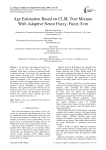
Age Estimation Based on CLM, Tree Mixture With Adaptive Neuron Fuzzy, Fuzzy Svm
Статья научная
As you know, age diagnosis based on the image is one of the most attractive topics in computer .In this paper, we present a intelligent model to estimate the age of face image. We use shape and texture feature extraction from FG-NET landmark image data set using AAM(Active Appearance Model), CLM (Constrained Local Model), tree Mixture algorithms. Finally, the obtained features were given as the training data to the ANFIS (adaptive neuro fuzzy influence system), FSVM (Fuzzy Support Vector Machine). Our experimental results show that In our proposed system, fuzzy svm has less errors and system worked more accurate and appropriative than prior methods. Our system is able to identify age of face image from different directions as is.
Бесплатно
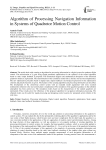
Algorithm of Processing Navigation Information in Systems of Quadrotor Motion Control
Статья научная
The article deals with creating an algorithm for processing information in a digital system for quadrotor flight control. The minimization of L2-gain using simple parametric optimization for the synthesis of the control algorithm based on static output feedback is proposed. The kinematical diagram and mathematical description of the linearized quadrotor model are represented. The transformation of the continuous model into a discrete one has been implemented. The new optimization procedure based on digital static output feedback is developed. Expressions for the optimization criterion and penalty function are given. The features of the creating algorithm and processing information are described. The development of the closed-loop control system with an extended model augmented with some essential nonlinearities inherent to the real control plant is implemented. The simulation of the quadrotor guidance in the turbulent atmosphere has been carried out. The simulation results based on the characteristics of the studied quadrotor are represented. These results prove the efficiency of the proposed algorithm for navigation information processing. The obtained results can be useful for signal processing and designing control systems for unmanned aerial vehicles of the wide class.
Бесплатно
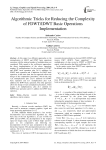
Algorithmic Tricks for Reducing the Complexity of FDWT/IDWT Basic Operations Implementation
Статья научная
In this paper two different approaches to the rationalization of FDWT and IDWT basic operations execution with the reduced number of multiplications are considered. With regard to the well-known approaches, the direct implementation of the above operations requires 2L multiplications for the execution of FDWT and IDWT basic operation plus 2(L-1) additions for FDWT basic operation and L additions for IDWT basic operation. At the same time, the first approach allows the design of the computation procedures, which take only 1,5L multiplications plus 3,5L+1 additions for FDWT basic operation and L+1 multiplications plus 3,5L additions for IDWT basic operation. The other approach allows the design of such computation procedures, which require 1,5L multiplications, plus 2L-1 addition for FDWT basic operation and L+1 addition for IDWT basic operation.
Бесплатно
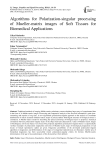
Статья научная
Traditional methods of imaging Muller-matrix polarimetry ensure obtaining large arrays of experimental data in the form of 16 Muller-matrix images. Processing and comparative analysis of the received information is quite time-consuming and requires a long time. A new algorithmic polarization-singular approach to the analysis of coordinate distributions of matrix elements (Mueller-matrix maps) of polycrystalline birefringent structure of biological tissues is considered. A Mueller-matrix model for describing the optical anisotropy of biological layers is proposed. Analytical correlations between polarization-singular states of the object field and characteristic values of Mueller-matrix images of birefringence soft tissue objects were found. The proposed algorithmic polarization-singular theory is experimentally verified. Examples of polarization singularities networks of Mueller-matrix maps of histological preparations of real tissues of female reproductive sphere are given. Diagnostic possibilities of the developed polarization-singular algorithms in diagnostics and differentiation of the stages of extragenital endometriosis are illustrated. Another area of biomedical diagnostics has been successfully tested: polarization-singular criteria for forensic Mueller-matrix determination of the age of myocardial injury of the deceased have been defined.
Бесплатно
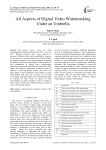
All Aspects of Digital Video Watermarking Under an Umbrella
Статья научная
The present review covers the video watermarking literature published from 1997 to the year 2015. Through extensive work, some selection is necessary. Therefore, only articles published by a process of peer review in archival journal are reviewed. Papers are grouped according to the implementation techniques and further divided into sub techniques. Many papers deal with fundamental of digital video watermarking, including experimental, numerical and analytical works. Others are related to application or natural system. In addition to reviewing journal articles, this review also takes papers of good conferences and meeting on video watermarking. The main aim of authors is to provide every details regarding digital video watermarking under an umbrella. In other words all aspects of video watermarking are placed together in order to helpful to those readers looking the complete literature related to video watermarking scheme.
Бесплатно
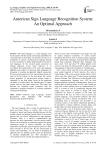
American sign language recognition system: an optimal approach
Статья научная
The Sign language is a visual language used by the people with the speech and hearing disabilities for communication in their daily conversation activities. It is completely an optical communication language through its native grammar, be unlike fundamentally from that of oral languages. In this research paper, presented an optimal approach, whose major objective is to accomplish the transliteration of 24 static sign language alphabets and numbers of American Sign Language into humanoid or machine decipherable English manuscript. Pre-processing operations of the signed input gesture are done in the first phase. In the next phase, the various region properties of pre-processed gesture image is computed. In the final phase, based on the properties calculated of earlier phase, the transliteration of signed gesture into text has been carried out. This paper also presents the statistical result evaluation with the comparative graphical depiction of existing techniques and proposed technique.
Бесплатно
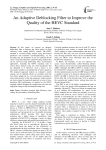
An Adaptive Deblocking Filter to Improve the Quality of the HEVC Standard
Статья научная
In this paper, we present an adaptive deblocking filter to improve the video quality for high efficiency video coding (HEVC) scheme. The HEVC standard is a hybrid coding scheme using block-based prediction and transform encoding/decoding. At the decoding step, the boundary of any two adjacent blocks causes visual discontinuities called blocking artifacts that can be removed using deblocking filter. Conventional approaches, including the HEVC standard, tend to remove those artifacts using two offset parameters that are defaulted to 0. However, such a choice is not necessarily suitable to encode/decode all video sequences. The proposed approach reduces an exhaustive search among a set of candidate offsets to eventually select the best offsets adaptively (i.e., for each frame) according to some characteristics of the data sequences. Improvements are shown using the proposed approach in terms of rate-distortion (RD) performance as opposed to the HEVC standard without changing the compression ratio and with negligible change in the encoding/decoding time.
Бесплатно
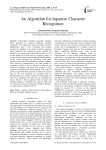
An Algorithm for Japanese Character Recognition
Статья научная
In this paper we propose a geometry- topology based algorithm for Japanese Hiragana character recognition. This algorithm is based on center of gravity identification and is size, translation and rotation invariant. In addition, to the center of gravity, topology based landmarks like conjunction points masking the intersection of closed loops and multiple strokes, as well as end points have been used to compute centers of gravity of these points located in the individual quadrants of the circles enclosing the characters. After initial pre-processing steps like notarization, resizing, cropping, noise removal, synchronization, the total number of conjunction points as well as the total number of end points are computed and stored. The character is then encircled and divided into four quadrants. The center of gravity (cog) of the entire character as well as the cogs of each of the four quadrants are computed and the Euclidean distances of the conjunction and end points in each of the quadrants with the cogs are computed and stored. Values of these quantities both for target and template images are computed and a match is made with the character having the minimum Euclidean distance. Average accuracy obtained is 94.1 %.
Бесплатно
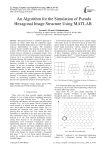
An Algorithm for the Simulation of Pseudo Hexagonal Image Structure Using MATLAB
Статья научная
Hexagonal structure is a different approach to represent an image rather than the traditional square structure. Hexagonal shaped pixels are used in hexagonal structure representation of images. The hexagonal structure closely resembles the structure of human visual systems (HVS) because the photo receptors found in human retina are arranged in a hexagonal manner. Also curved structure can be well represented using hexagonal structure. So if we could able to represent the image in hexagonal domain, the computer vision will be as close to human vision. But in the present scenario there is no hardware available to capture or display hexagonal images. So we have to simulate a hexagonal grid on a regular square pixel image for further processing in hexagonal domain. In this paper, a new method for constricting a pseudo hexagonal structure using square pixel is presented. This method preserves the important property of hexagonal architecture that each pixel has exactly six surrounding neighbors. This method also preserves the equidistance property of hexagonal pixels.
Бесплатно
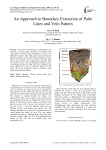
An Approach to Boundary Extraction of Palm Lines and Vein Pattern
Статья научная
The palm vein biometrics is automated tool to recognize a person based on human vein pattern. The vein pattern is intrinsic and subcutaneous so that is very difficult to forge or fake. This paper discusses about the feature extraction of the hand based recognition system that involves features like vein pattern, principal lines and secondary lines. The morphological operations such as opening, closing and edge detection technique like canny algorithm are used to extract the feature set. The result shows the prominent feature extraction using image processing techniques.
Бесплатно
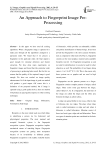
An Approach to Fingerprint Image Pre-Processing
Статья научная
In this paper we have used all existing algorithms. When a fingerprint image is captured it is made pass through all the algorithms arranged in a particular order. We found that if we process a fingerprint in this particular order, the final output is good enough for minutiae detection and feature extraction. We have done many experiments on fingerprint images and found that this particular order of processing is producing better result. But for this we assume that the quality of the captured image is good enough. We have not worked on image quality enhancement. So if the input image is good our method will produce a good output. Off course this is a limitation of our proposed method, but if image is captured using a good quality device, then our method will produce an equal quality output as in other existing techniques.
Бесплатно
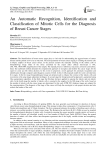
Статья научная
The identification of breast cancer stages plays a vital role for understanding the aggressiveness of cancer disease and the patient survival as an outcome. The main parameter of breast cancer staging is counting the mitotic cells in biopsy samples of breast cancer tissues. In the present scenario the manually counting of the mitotic cells in histopathology image slides of the tissue examined by the expert under clinical microscope is 10X, 20X ,40X ,100X,400X magnification of the sample. The manual process is laborious, inaccurate, erroneous and tedious, hence the traditional method demands the computerized approach to recognize and identify the cancer stages for the expert to come up with robust decision. In this work we proposed a novel approach for automatic recognition and identification through computer aided diagnosis systems (CAD). In this CAD proposed model the work is divided into five stages. In the first stage histopathological image are preprocessed to enhance the contrast of the mitotic cells and non mitotic cells using image adjustment technique. In second stage the foreground and background is segmented using Otsu segmentation algorithm. In the third stage the Bit plane slicing is applied to separate the mitotic and non mitotic cells. In the fourth stage the number of mitotic cells is counted in the samples. In the fifth stage of the work, based on the number of mitotic cells the cancer stages are determined. In this work, ICPR 2012 database images are adopted for the experimentation. The diagnosis of the stage of the cancer will help the oncologist to take proper decision and also reduces the burden of the work.
Бесплатно
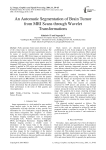
An Automatic Segmentation of Brain Tumor from MRI Scans through Wavelet Transformations
Статья научная
Fully automatic brain tumor detection is one of the critical tasks in medical image processing. The proposed study discusses the tumor segmentation process by means of wavelet transformation and clustering technique. Initially, MRI brain images are preprocessed by various wavelet transformations to sharpen the images and enhance the tumor region. This helps to quicken the clustering technique since tumor region appears good in sharpened CSF region. Finally, a wavelet decomposition method is applied in CSF region and extracts the tumor portion. This proposed method analyzes the performance of various wavelet types such as Haar, Daubechies (db1, db2, db3, db4 and db5), Coiflet, Morlet and Symlet in MRI scans. Experiments with the proposed method were done on 5 volume datasets collected from the popular brain tumor pools are BRATS2012 and whole brain atlas. The quantitative measures of results were compared using the metrics false alarm (FA) and missed alarm (MA). The results demonstrate that the proposed method obtaining better performance in the terms of both quantity and visual appearance.
Бесплатно
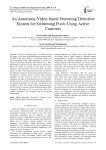
An Automatic Video-based Drowning Detection System for Swimming Pools Using Active Contours
Статья научная
Safety in swimming pools is a crucial issue. In this paper, a real time drowning detection method based on HSV color space analysis is presented which uses prior knowledge of the video sequences to set the best values for the color channels. Our method uses a HSV thresholding mechanism along with Contour detection to detect the region of interest in each frame of video sequences. The presented software can detect drowning person in indoor swimming pools and sends an alarm to the lifeguard rescues if the previously detected person is missing for a specific amount of time. The presented algorithm for this system is tested on several video sequences recorded in swimming pools in real conditions and the results are of high accuracy with a high capability of tracking individuals in real time. According to the evaluation results, the number of false alarms generated by the system is minimal and the maximum alarm delay reported by the system is 2.6 sec which can relatively be reliable compared to the acceptable time for rescue and resuscitation.
Бесплатно
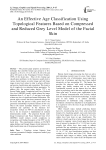
Статья научная
The present paper proposes an innovative technique that classifies human age group in to five categories i.e 0 to 12, 13 to 25, 26 to 45, 46 to 60, and above 60 based on the Topological Texture Features (TTF) of the facial skin. Most of the existing age classification problems in the literature usually derive various facial features on entire image and with large range of gray level values in order to achieve efficient and precise classification and recognition. This leads to lot of complexity in evaluating feature parameters. To address this, the present paper derives TTF’s on Second Order image Compressed and Fuzzy Reduced Grey level (SICFRG) model, which reduces the image dimension from 5 x 5 into 2 x 2 and grey level range without any loss of significant feature information. The present paper assumes that bone structural changes do not occur after the person is fully grown that is the geometric relationships of primary features do not vary. That is the reason secondary features i.e TTF’s are identified and exploited. In the literature few researchers worked on TTF for classification of age, but so far no research is implemented on reduced dimensionality model. The proposed Second order Image Compressed and Fuzzy Reduced Grey level (SICFRG) model reduces overall complexity in recognizing and finding histogram of the TTF on the facial skin. The experimental evidence on FG-NET aging database and Google Images clearly indicates the high classification rate of the proposed method.
Бесплатно

